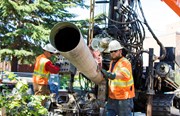How to Effectively Write Job Descriptions That Help You Score the Best Employees
By: Jessica AlexanderAttracting candidates to fill open positions, particularly those in field roles, is more difficult than ever. Alongside the challenge of recruiting talent is retaining it. One of the key reasons employee turnover occurs in the first 30 to 90 days of employment is mismatched expectations. Either the employee did not understand the true nature of the role and the expectations of the job, or possibly the company did not convey the position accurately.
So how can we ensure this doesn’t happen within our organization? How can we help our company recruit and retain talent that will stick? Being clear in our expectations using a well-written job description and using predictive analytics are key strategies to consider.
Understand and Evaluate Critical Roles
The first step in improving job descriptions for key roles is to identify the positions within your organization that are considered critical for your company to run smoothly. In environmental drilling, field labor and operations positions meet that definition. Once you know which roles are most needed for your company, take a look at the current job descriptions you’re using to recruit, and ask yourself:
- Does this job description reflect the true nature of the job?
- Do others in the organization agree that it is reflective of the job?
- Does it adequately explain to the prospective candidate the value we offer that other companies can’t or don’t?
- Are the requirements and qualifications listed necessary for the role, or are they considered more “nice to haves”?
- Is there language in the job description that might imply we are likely to be biased in favor of a specific type of candidate?
- Have we included at least five top priorities of the job?
- Does the job description contain information about the total rewards (meaning compensation, benefits and perks)?
- Are all major aspects of the job covered in the description, regardless of if they may seem unfavorable to applicants?
These questions should help you understand whether your current job descriptions are as effective as they can possibly be. Don’t be afraid to get other organizational leaders and managers involved and ask for their feedback. The more professionals that review the description, the more well-rounded your insights will be.
Ask New Employees for Feedback
One of the easiest ways to find out if your job descriptions are attracting the right employees is to ask! This can be done informally in a conversation with new employees or more formally on a new hire survey.
“Do you feel that the job description explained to you during the recruitment process was honest, accurate, and reflective of the actual position? If not, can you tell us why, or what should have been clarified?”
Keeping an eye on turnover trends is another way that you can consider employee feedback. If 80% of your employees are leaving the organization within the first 30, 60, or 90 days, that might indicate that the job is not what they thought it would be. If you don’t utilize exit surveys or interviews, you should absolutely consider adding one to your off-boarding processes to capture that feedback.
Use Predictive Analytics
“Predictive analytics is the use of data, statistical algorithms, and machine learning techniques to identify the likelihood of future outcomes based on historical data” (https://www.sas.com/en_us/insights/analytics/predictive-analytics.html). While this concept may seem to be entirely separate from job design and descriptions, predictive analytics can aid leaders in crafting job descriptions that attract the absolute best candidate for the role.
Consider the following example:
Your current job description for an environmental technician lists the following five competencies as crucial for the role:
- Critical thinking
- Time management
- Mechanically inclined
- Problem solving
- Strong oral and written communication skills
Your organization decides to engage with a third party to use predictive analytics. This process entails surveying the top 10 environmental technicians in your company, and through that process, you create your “ideal candidate profile.” Your ideal candidate profile identifies the following as the top five competencies of those who are already successful in this role:
- Teamwork skills
- Autonomous worker
- Attention to detail
- Researching skills
- Critical thinking
As you can see in this example, there’s a bit of disconnect between what the job description says is important and what competencies actually define success for existing employees in the role. This is one way that you can use predictive analytics to help craft your ideal job description that will recruit not just any employee, but the right employee.
While writing a solid job description won’t make your company immune to recruiting challenges, it will ensure that you’re advertising your job accurately to the labor market and increase your chance of making the right hire.
Want to chat further around best practices for crafting spot-on job descriptions? Email me at [email protected].
ABOUT THE AUTHOR

Jessica Alexander, SHRM-SCP
DIRECTOR OF TALENT ACQUISITION
[email protected]
Jessica Alexander is the Director of Talent Acquisition for Cascade Environmental, LLC. She holds a B.S. in Human Resource Management, B.S. in Business Administration, MBA, and Doctorate of Philosophy (ABD) in Human Resource Management. After completing ten years of military service in the United States Air Force in the Logistics and Transportation Management field, Jessica launched a distinguished career specializing in recruiting and talent development. She is passionate about the development of people and their ability to drive companies forward.





